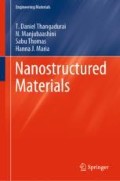Abstract
Nanostructured materials in the area of optical and electronic applications are advancing more with more device development as solar panels, optoelectronic switches, batteries and sensors. This chapter particularly focuses on the optoelectronic applications. All electronic tools have one thing in common: an integrated circuit (IC) acting as their brain. Nano-electromechanical systems have evolved early years and creating sensors eyes and actuators arms at the same scale as the accompanying nanoelectronics. Recent developments in synthesis of nanomaterials with excellent electrical and mechanical properties have extended the boundaries of NEMS applications to include more advanced devices such as the non-volatile nano-electro-mechanical memory, where information is transferred and stored through a series of electrical and mechanical actions at the nanoscale (Venkateswara Rao and Kumar Yadav in Int J Eng Sci 4:6–9, 2015 [1]).
Access this chapter
Tax calculation will be finalised at checkout
Purchases are for personal use only
References
Venkateswara Rao A, Kumar Yadav S (2015) An introduction to nano electro mechanical systems. Int J Eng Sci 4:6–9
Afshar EN, Xosrovashvili G, Rouhi R et al (2015) Review on the application of nanostructure materials in solar cells. Mod Phys Lett B 29:1550118–1550124
Giannouli M (2013) Nanostructured ZnO, TiO2, and composite ZnO/TiO2 films for application in dye-sensitized solar cells. Int J Photoenergy 612095:1–8
Cammi D, Ronning C (2014) Persistent photoconductivity in ZnO nanowires in different atmospheres. Adv Cond Matter Phys 184120:1–5
Kind H, Yan H, Messer B et al (2002) Nanowire ultraviolet photodetectors and optical switches’. Adv Mater 14:158–160
Schneemann A, White JL, Young Kang S et al (2018) Nanostructured metal hydrides for hydrogen storage. Chem Rev 118:10775–10839
Shih CC, Lee WY, Chen WC (2016) Nanostructured materials for non-volatile organic transistor memory applications. Mater Horiz 3:294–308
Peter Reithmaier J, Petkov P, Kulisch W et al (2008) Nanostructured materials for advanced technological applications. In: Proceedings of the NATO advanced study institute on nanostructured materials for advanced technological applications, Sozopol. Springer, Netherlands
Qiao XG, Gao N, Moktadir Z et al (2010) Fabrication of MEMS components using ultra-fine grained aluminium. J Micromech Microeng 20:045029–045041
Mina AN, Phillips AH (2013) Graphene transistor. JASR 9:1854–1874
Bachtold A, Hadley P, Nakanishi T et al (2001) Logic circuits with carbon nanotube transistors. Science 294:1317–1319
Credi A, Semeraro M, Silvi S et al (2011) Redox control of molecular motion in switchable artificial nanoscale devices. Antioxid Redox Signal 14:1119–1165
Hu P, Zhang J, Li L et al (2010) Carbon nanostructure-based field-effect transistors for label-free chemical/biological sensors. Sensors 10:5133–5159
Gautam A (2012) Spintronics—a new hope for the digital world. IJSR 2:1
Author information
Authors and Affiliations
Corresponding author
Rights and permissions
Copyright information
© 2020 Springer Nature Switzerland AG
About this chapter
Cite this chapter
Thangadurai, T.D., Manjubaashini, N., Thomas, S., Maria, H.J. (2020). Nanostructured Materials for Optical and Electronic Applications. In: Nanostructured Materials. Engineering Materials. Springer, Cham. https://doi.org/10.1007/978-3-030-26145-0_12
Download citation
DOI: https://doi.org/10.1007/978-3-030-26145-0_12
Published:
Publisher Name: Springer, Cham
Print ISBN: 978-3-030-26144-3
Online ISBN: 978-3-030-26145-0
eBook Packages: Chemistry and Materials ScienceChemistry and Material Science (R0)

